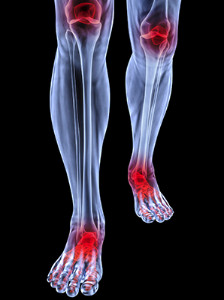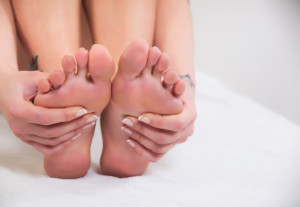
Drexel Hill (484) 521-0233
West Chester (610) 436-5883

Drexel Hill (484) 521-0233
West Chester (610) 436-5883
 Rheumatoid arthritis affects approximately 400,000 people in the UK. Most sufferers tend to be between the ages of 40 and 50. This condition is known to affect the joints, and many people experience the effects of arthritis in their feet. Some of the initial warning signs of rheumatoid arthritis are swelling, redness, or tenderness in the joints. If you suffer from joint pain and tenderness for a period lasting around or longer than six weeks, there is a good chance you may be suffering from arthritis. Another common symptom is stiffness felt in the joints when first waking up. Often times, joints in the feet will become painful in those with rheumatoid arthritis. Additionally, many arthritis sufferers notice that if a joint on one side of the body is in pain, the same joint on the other side of the body will be in pain as well. If you are afflicted with this condition it’s suggested to schedule a consultation with a podiatrist to determine the severity of this ailment and discuss the best treatments options available.
Rheumatoid arthritis affects approximately 400,000 people in the UK. Most sufferers tend to be between the ages of 40 and 50. This condition is known to affect the joints, and many people experience the effects of arthritis in their feet. Some of the initial warning signs of rheumatoid arthritis are swelling, redness, or tenderness in the joints. If you suffer from joint pain and tenderness for a period lasting around or longer than six weeks, there is a good chance you may be suffering from arthritis. Another common symptom is stiffness felt in the joints when first waking up. Often times, joints in the feet will become painful in those with rheumatoid arthritis. Additionally, many arthritis sufferers notice that if a joint on one side of the body is in pain, the same joint on the other side of the body will be in pain as well. If you are afflicted with this condition it’s suggested to schedule a consultation with a podiatrist to determine the severity of this ailment and discuss the best treatments options available.
Because RA affects more than just your joints, including the joints in your feet and ankles, it is important to seek early diagnosis from your podiatrist if you feel like the pain in your feet might be caused by RA. For more information, contact the podiatrists of Dr. Siegerman & Associates. Our doctors will assist you with all of your podiatric concerns.
What Is Rheumatoid Arthritis?
Rheumatoid Arthritis (RA) is an autoimmune disorder in which the body’s own immune system attacks the membranes surrounding the joints. Inflammation of the lining and eventually the destruction of the joint’s cartilage and bone occur, causing severe pain and immobility.
Rheumatoid Arthritis of the Feet
Although RA usually attacks multiple bones and joints throughout the entire body, almost 90 percent of cases result in pain in the foot or ankle area.
Symptoms
Diagnosis
Quick diagnosis of RA in the feet is important so that the podiatrist can treat the area effectively. Your doctor will ask you about your medical history, occupation, and lifestyle to determine the origin of the condition. Rheumatoid Factor tests help to determine if someone is affected by the disease.
If you have any questions please feel free to contact one of our offices located in Drexel Hill and West Chester, PA . We offer the newest diagnostic and treatment technologies for all your foot and ankle needs.
 If you notice your toenail is becoming thicker and turning a white or yellowish color, you may have toenail fungus. This type of infection develops when fungi grows under the skin, and you may experience discomfort. For severe infections, the nail may separate from the nail bed, and begin to disintegrate which may typically cause pain. Like other types of fungus, toenail fungus generally grows in moist and warm places, which make the toenails a perfect place for the development of this ailment. There are several ways to prevent this contagious fungus from developing including wearing appropriate shoes while in public showers and surrounding areas, trimming the toenails regularly, and wearing clean socks and shoes. After a proper diagnosis is performed, the appropriate treatment may begin. Please consider scheduling a consultation with a podiatrist for information about treatment options that are correct for you.
If you notice your toenail is becoming thicker and turning a white or yellowish color, you may have toenail fungus. This type of infection develops when fungi grows under the skin, and you may experience discomfort. For severe infections, the nail may separate from the nail bed, and begin to disintegrate which may typically cause pain. Like other types of fungus, toenail fungus generally grows in moist and warm places, which make the toenails a perfect place for the development of this ailment. There are several ways to prevent this contagious fungus from developing including wearing appropriate shoes while in public showers and surrounding areas, trimming the toenails regularly, and wearing clean socks and shoes. After a proper diagnosis is performed, the appropriate treatment may begin. Please consider scheduling a consultation with a podiatrist for information about treatment options that are correct for you.
If left untreated, toenail fungus may spread to other toenails, skin, or even fingernails. If you suspect you have toenail fungus it is important to seek treatment right away. For more information about treatment, contact the podiatrists of Dr. Siegerman & Associates. Our doctors can provide the care you need to keep you pain-free and on your feet.
Symptoms
Treatment
If self-care strategies and over-the-counter medications does not help your fungus, your podiatrist may give you a prescription drug instead. Even if you find relief from your toenail fungus symptoms, you may experience a repeat infection in the future.
Prevention
In order to prevent getting toenail fungus in the future, you should always make sure to wash your feet with soap and water. After washing, it is important to dry your feet thoroughly especially in between the toes. When trimming your toenails, be sure to trim straight across instead of in a rounded shape. It is crucial not to cover up discolored nails with nail polish because that will prevent your nail from being able to “breathe”.
In some cases, surgical procedure may be needed to remove the toenail fungus. Consult with your podiatrist about the best treatment options for your case of toenail fungus.
If you have any questions, please feel free to contact one of our offices located in Drexel Hill and West Chester, PA . We offer the newest diagnostic and treatment technologies for all your foot care needs.
 Diabetic patients have an urgent need to take proper care of their feet, and this may possibly discourage serious foot conditions from occurring. The body’s healing process is often slowed because of diabetes, and research has shown it's important to treat minor cuts daily to possibly prevent infections from developing. Sores, blisters or cracked skin can be additional ailments that may occur as a result of being diabetic and should be treated appropriately. There are several preventative measures that may be executed which will not only feel good, but may aid in the prevention of foot ailments forming. These may include washing the feet in warm water and thoroughly drying the feet, before utilizing a moisturizing lotion to soften the skin. Additionally, when the nails are trimmed straight across, the likelihood of developing ingrown toenails may diminish because the nails won’t be cutting into the corners of the skin. A consultation with a podiatrist is suggested to learn about proper treatment and preventive techniques for diabetic feet.
Diabetic patients have an urgent need to take proper care of their feet, and this may possibly discourage serious foot conditions from occurring. The body’s healing process is often slowed because of diabetes, and research has shown it's important to treat minor cuts daily to possibly prevent infections from developing. Sores, blisters or cracked skin can be additional ailments that may occur as a result of being diabetic and should be treated appropriately. There are several preventative measures that may be executed which will not only feel good, but may aid in the prevention of foot ailments forming. These may include washing the feet in warm water and thoroughly drying the feet, before utilizing a moisturizing lotion to soften the skin. Additionally, when the nails are trimmed straight across, the likelihood of developing ingrown toenails may diminish because the nails won’t be cutting into the corners of the skin. A consultation with a podiatrist is suggested to learn about proper treatment and preventive techniques for diabetic feet.
Diabetic foot care is important in preventing foot ailments such as ulcers. If you are suffering from diabetes or have any other concerns about your feet, contact the podiatrists from Dr. Siegerman & Associates. Our doctors can provide the care you need to keep you pain-free and on your feet.
Diabetic Foot Care
Diabetes affects millions of people every year. The condition can damage blood vessels in many parts of the body, especially the feet. Because of this, taking care of your feet is essential if you have diabetes, and having a podiatrist help monitor your foot health is highly recommended.
The Importance of Caring for Your Feet
Patients with diabetes should have their doctor monitor their blood levels, as blood sugar levels play such a huge role in diabetic care. Monitoring these levels on a regular basis is highly advised.
It is always best to inform your healthcare professional of any concerns you may have regarding your feet, especially for diabetic patients. Early treatment and routine foot examinations are keys to maintaining proper health, especially because severe complications can arise if proper treatment is not applied.
If you have any questions please feel free to contact one of our offices located in Drexel Hill and West Chester, PA . We offer the newest diagnostic and treatment technologies for all your foot and ankle needs.
 Many new runners experience injuries that occur from running, and recent research has suggested that it's helpful to learn about preventative techniques. Performing proper stretches before running any type of distance is important in maintaining flexibility, but stretching too deeply may result in developing pulled muscles. It’s suggested that stretching should start at a slower pace, enabling the tendons and ligaments to warm up. "Overuse injuries" are common among runners, and these may include shin splints, sprains, and stress fractures. If you start your warm-up practice by walking at a slow pace before starting the run, the possibility of incurring injuries may be diminished. This enables the cells and fibers in the muscles to gradually tear and then rebuild stronger than they were. If you are contemplating incorporating running into your regular routine, please consult with a podiatrist for additional information on how to prevent running injuries to the foot and ankle.
Many new runners experience injuries that occur from running, and recent research has suggested that it's helpful to learn about preventative techniques. Performing proper stretches before running any type of distance is important in maintaining flexibility, but stretching too deeply may result in developing pulled muscles. It’s suggested that stretching should start at a slower pace, enabling the tendons and ligaments to warm up. "Overuse injuries" are common among runners, and these may include shin splints, sprains, and stress fractures. If you start your warm-up practice by walking at a slow pace before starting the run, the possibility of incurring injuries may be diminished. This enables the cells and fibers in the muscles to gradually tear and then rebuild stronger than they were. If you are contemplating incorporating running into your regular routine, please consult with a podiatrist for additional information on how to prevent running injuries to the foot and ankle.
All runners should take extra precaution when trying to avoid injury. If you have any concerns about your feet, contact the podiatrists of Dr. Siegerman & Associates. Our doctors will treat your foot and ankle needs.
How to Prevent Running Injuries
There are a lot of mistakes a runner can make prior to a workout that can induce injury. A lot of athletes tend to overstretch before running, instead of saving those workouts for a post-run routine. Deep lunges and hand-to-toe hamstring pulls should be performed after a workout instead of during a warmup. Another common mistake is jumping into an intense routine before your body is physically prepared for it. You should try to ease your way into long-distance running instead of forcing yourself to rush into it.
More Tips for Preventing Injury
If you have any questions, please feel free to contact one of our offices located in Drexel Hill and West Chester, PA . We offer the newest diagnostic and treatment technologies for all your foot care needs.
Request a free copy of
Laser Away Foot Pain!
today.
